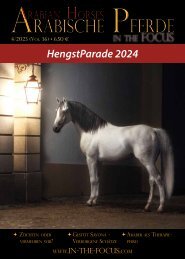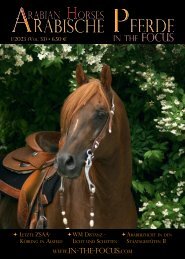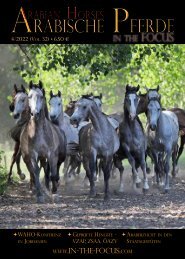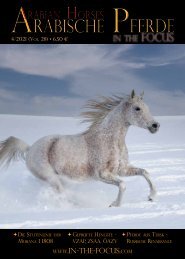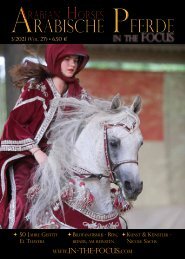Arabische Pferde IN THE FOCUS Nr. 1/2020 (Vol. 21) - Preview
Die Zeitschrift für Freunde und Züchter arabischer Pferde
Die Zeitschrift für Freunde und Züchter arabischer Pferde
Sie wollen auch ein ePaper? Erhöhen Sie die Reichweite Ihrer Titel.
YUMPU macht aus Druck-PDFs automatisch weboptimierte ePaper, die Google liebt.
Genetic Research (II)<br />
Speed and<br />
Endurance<br />
Zucht<br />
In the last issue we looked at the domestication and emergence of the various<br />
horse breeds under new genetic findings. This second part will deal with various traits,<br />
such as the genetic basis for speed and endurance.<br />
Since the domestication of the horse until<br />
today, humans have created a large<br />
number of different horse breeds, which<br />
have the most varied properties, depending<br />
on what their area of use is. It is therefore<br />
not surprising that different horse breeds<br />
also have different dispositions to build muscle<br />
mass. There are short-distance runners<br />
(sprinters) who have to exert high power over<br />
a short period of time and distance, such as<br />
the Quarter Horse, which is bred for 400 m races.<br />
And then there are long-distance runners<br />
(stamina), whose strength is the persistent<br />
muscle work in long races, up to endurance<br />
rides of 160 km.<br />
The gene for muscle growth<br />
The protein myostatin (MSTN), which inhibits<br />
muscle growth, is responsible for the amount<br />
of muscles. If this protein is inhibited due to a<br />
mutation, there is increased muscle growth.<br />
This mutation was identified a few years ago:<br />
the base thymine (T) was replaced with cytosine<br />
(C). If a horse has this mutation (C / C<br />
instead of T / T), the horse has more muscle<br />
power for short sprints. This gene was therefore<br />
called the "speed gene". Accordingly,<br />
there are three different genotypes, and the<br />
following properties have been postulated:<br />
C / C - homozygous for the C allele, these are<br />
the sprinters among the racehorses that have<br />
a high proportion of muscle mass in relation<br />
to the total weight and are suitable for short,<br />
fast races - they are also usually early maturing.<br />
Horses with T / T are homozygous for the<br />
T allele and therefore have the other variant<br />
of the myostatin gene. These are the stayers,<br />
the endurance runners, who are usually lighter,<br />
i.e. have less muscle mass and are more<br />
suitable for long distances - they are usually<br />
also late maturing. And of course there are C<br />
/ T, i.e. heterozygous horses, which are particularly<br />
suitable for medium distances.<br />
The team led by Mim Bower (2012) from<br />
Cambridge University examined different<br />
breeds for the frequency of C / C and T / T. It<br />
turned out that the oriental breeds, which includes<br />
the Arabian horse, had only 3% C / C,<br />
against it 87% T / T, the remaining 10% were<br />
C / T. It looked very different with the English<br />
Thoroughbred. Here, 46% of the sprinters<br />
were homozygous C / C, and only 7% T / T,<br />
the difference again C / T. In the stayers, i.e.<br />
English Thoroughbreds that run over 1800 m<br />
and more, it was only 3% C / C and 35% T / T,<br />
the majority - namely 61% were mixed C / T.<br />
Therefore, English Thoroughbreds could not<br />
have inherited its speed from its oriental ancestors,<br />
especially not on the relatively short<br />
distances (up to 1800 m). So, where did it<br />
come from?<br />
The speed gene<br />
The answer to this was surprising: Apparently,<br />
this mutation was only introduced once<br />
into the gene pool during the founding phase<br />
of the English Thoroughbred, by a mare born<br />
in Great Britain, possibly even a Shetland<br />
pony! In the British Shetland pony, 38% of the<br />
animals examined were homozygous for C /<br />
C, 38% homozygous T / T, the rest (25%) were<br />
mixed. By the way, the highest rate for C / C<br />
can be found at the American Quarter Horse,<br />
the sprint specialist (83% C / C), which was<br />
bred for 400 m races.<br />
The same team of researchers also examined<br />
the DNA of "historical skeletons", namely Thoroughbreds<br />
that were born between 1849<br />
and 1930. Well-known names like Eclipse,<br />
Hyperion, Persimmon and St. Simon were<br />
among them. All 12 animals examined were<br />
T / T. So back then T / T was predominant, today<br />
C / C - how did this shift come about? The<br />
explanation lies in the changed conditions<br />
Apparently the "speed" Mutation<br />
was only introduced<br />
once into the gene pool of<br />
the English Thoroughbred.<br />
30<br />
© ARABISCHE PFERDE - <strong>IN</strong> <strong>THE</strong> <strong>FOCUS</strong> 1/<strong>2020</strong>



